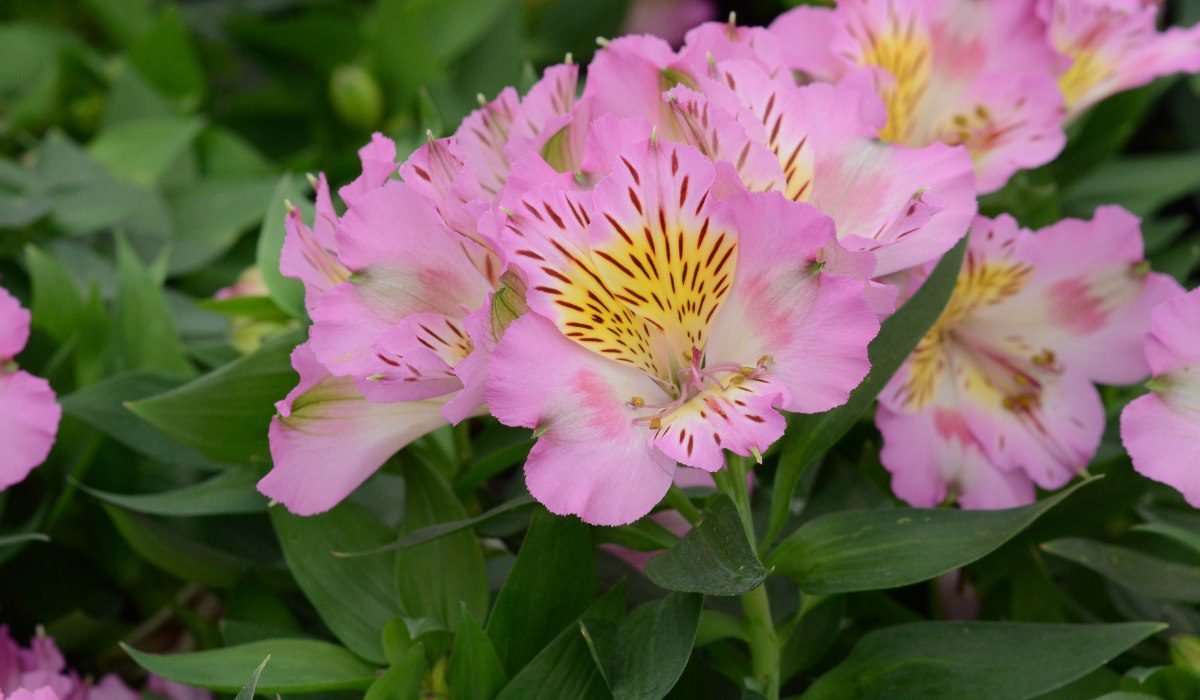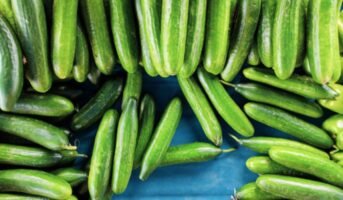The alstroemeria is like the superstar of cut flowers, always making mixed bouquets look great. Its blooms stick around for about two weeks, and they come in so many colours, it’s like having a rainbow in your vase. Originally from South America, it goes by names like Peruvian Lily and Lily of the Incas. This tough plant not only gets sold a lot in flower markets but has also found a cosy spot in home gardens.
They are more fascinating because of their flowers and are often compared to Orchids for their looks. They show off their vibrant and flashy colours during the summer. You’ll find these flowers bunched up on strong, leafy stems, and if you take a peek inside, you’ll see pretty patterns that give them a fancy, lily-like appearance.
See also: How to grow and take care of blueberry plants?
Alstroemeria: Key facts
| Botanical name | Alstroemeria aurea |
| Common name | Peruvian Lily, Lily of the Incas |
| Family | Alstroemeriaceae |
| Native area | Central Chile, Brazil |
| Flower size | 2 inch |
| Sun exposure | Full or partial sun exposure |
| Soil type | Well Drained Soil |
| Flower colour | Orange, Pink, Purple, Red, White |
| Toxic | Semi-Toxic |
How to care for Alstroemeria?
Light – Peruvian lilies love a lot of sunlight, around six to eight hours a day. But if it’s really hot, they appreciate some shade in the afternoon.
Soil – For their soil, it’s best if it’s fertile and drains well. The soil can be made better by adding compost or leaf mould also they’re okay with regular garden soil which has a pH of around 5.5 to 6.5 pH.
Water – Water them regularly, especially when it gets hot in the summer. Give them about an inch of water every week or when the soil on top feels dry.
Temperature and Humidity – A temperature between 65 and 80 degrees Fahrenheit is very much ideal for these plants and if it gets hotter, like in the upper 90s, they might grow stems without flowers. To avoid this, plant their seeds in a place where there is some shade or only morning sun falls on the plant. In humid places, make sure there’s enough space between them to let the air move and prevent fungal diseases.
Fertilizer – For more flowers regular fertilizer is required every two weeks and natural stuff like manure and compost tea can be used for rapid growth.
How to grow Alstroemeria?
Optimal Placement of Alstroemeria: Situate your Alstroemeria in an environment where daily temperatures hover below 20°C (68°F). Prioritize soil that boasts effective drainage. Select a location that receives partial shade to full sunlight.
Implanting Alstroemeria with Precision: Commence the Alstroemeria planting process by immersing the bulbs in water. Carve out holes in the soil or chosen potting medium. Embed the bulbs with care. Maintain consistent soil moisture through frequent watering.
Nurturing Alstroemeria with Diligence: Attend to your Alstroemeria’s hydration needs, providing water when the soil becomes parched. Administer fertilizer during the blooming phase. Shield the plant by applying mulch. Opt for a selective approach by picking, not cutting, the flowers. Stay vigilant against potential pests and diseases. Foster propagation by dividing Alstroemeria through the rhizomes.
Types of Alstroemeria
There are a vast number of species present in this segment more than 120 species some of them are:
The Bali Alstroemeria has lovely golden-apricot flowers with red and mahogany streaks. These vibrant colours make it a great companion for other summer blooms. With a shorter height of 32 inches, it’s perfect for small gardens or pots.
Candy Alstroemeria, true to its name, has charming candy-pink flowers. Standing at 3 feet tall, it’s a sturdy choice, especially for beginners.
Fougere Alstroemeria is a white variety with pink accents, growing up to 28 inches. Ideal for small gardens, but be cautious as it may cause minor skin irritations.
Inca Ice, reaching three feet, displays creamy yellow or apricot petals with burgundy streaks. Its slender leaves make it a great border plant, and it benefits from winter mulching.
Indian Summer Alstroemeria boasts bronze leaves and bright copper-orange or golden petals. Growing over 28 inches, it attracts butterflies and thrives in full sun or partial shade.
Princess Fabian, at one foot tall, suits pots and containers. Its creamy white petals with light yellow accents stand out against dark green leaves, preferring slightly moist soil and indirect sunlight.
Alstroemeria Aurea, for zones 7–10, showcases clusters of yellow or orange lily-like flowers on stems 2 to 3 feet tall. Its elegance is defined by specific cultivation requirements for those geographic zones.
Common problems when growing Alstroemeria
The issue of plants falling over is a prevalent one, particularly among species boasting abundant flowers and somewhat slender stems. The tendency for such plants, often cultivated for their appeal as cut flowers, to hang can be effectively addressed by providing support through staking the delicate flower stems.
A prominent indication of problems in plants, even when adequately watered, displays as the wilting of stems and leaves—a classical symptom of root rot initiated by diverse fungal agents. Primarily prevalent in warm and humid conditions, proactive measures to prevent root rot involve ensuring the soil’s porosity and promoting effective drainage.
A recurring phenomenon in Peruvian lilies involves a gradual end of flowering as the tubers mature, despite the sustained life of the plants. Typically occurring when plants reach the age of five or six years, the remedy for this idleness is to undertake the task of lifting and dividing the tuberous roots.
Alstroemeria: Toxicity
Alstroemeria, in all its parts, has the potential to be harmful due to toxicity. This toxicity arises from a compound called Tulipalin A., which is generated when the plant’s tissues suffer damage, such as through a cut. The sap of the alstroemeria plant harbours a substance known as Tuliposide A. The enzymes in this compound produce allergens, as documented by the Botanical Dermatology Database.
FAQs
Where is the optimal location for the best growth of Alstroemeria?
Peruvian Lilies flourish in areas basking in full morning sunlight, coupled with a touch of shade in the afternoons. Their prosperity is most pronounced in fertile, moist soils characterized by impeccable drainage. It is imperative to note that these resilient plants generally withstand winter conditions within growing zones 7 to 10.
What measures should one take to ensure the survival of Alstroemeria?
Alstroemeria, or Peruvian Lilies, demand a judicious approach to watering, as excessive moisture can induce root decay. Therefore, it is advisable to water these plants only when the soil appears parched. Enhance the longevity of their vibrant bloom season by administering Alstroemeria fertilizer during this period, effectively prolonging the flowering phase.
Can Alstroemeria be cultivated in containers?
Indeed, Alstroemeria can be successfully cultivated in pots. It is essential to select a sufficiently capacious container, ensuring the plant remains adequately hydrated, especially in warm weather. Additionally, for support, a sturdy structure, such as a garden cane, should be introduced to accommodate the height potential of the Alstroemeria stem, which may extend up to a meter.
Is Alstroemeria Indian Summer Hardy?
Despite the exotic allure of its blossoms, Alstroemeria, particularly the Indian Summer variety, demonstrates hardiness. Winter protection becomes requisite only when temperatures plummet below -10 degrees Celsius.
During which season does Alstroemeria typically thrive?
Alstroemeria, recognized as Peruvian Lilies or Princess Lilies, manifests as petite flora adorned with lush foliage, showcasing an abundance of vibrant blooms from late spring through early autumn. Noteworthy for their contrasting hues and charming tendrils, these blooms boast an impressive vase life of up to two weeks.
What is the timeframe for Alstroemeria to initiate flowering?
Upon replanting the bulbs, positioning them six inches deep in pots or spacing them 12 to 18 inches apart in the ground, the flowering phase of Alstroemeria commences after approximately 10 to 15 weeks. This flowering phenomenon persists for a span of two to four years.
Can Alstroemeria be propagated from seeds?
To propagate Alstroemeria from seeds, sow them in rows at a depth of 1/4
| Got any questions or point of view on our article? We would love to hear from you. Write to our Editor-in-Chief Jhumur Ghosh at [email protected] |
Priya Banerjee, a writer with a keen eye on the property market, she deciphers the ever-changing trends in residential real estate. Priya excels at simplifying complex real estate terms, making them easy for everyone to understand. Her well-researched advice helps buyers and investors understand complex topics.











